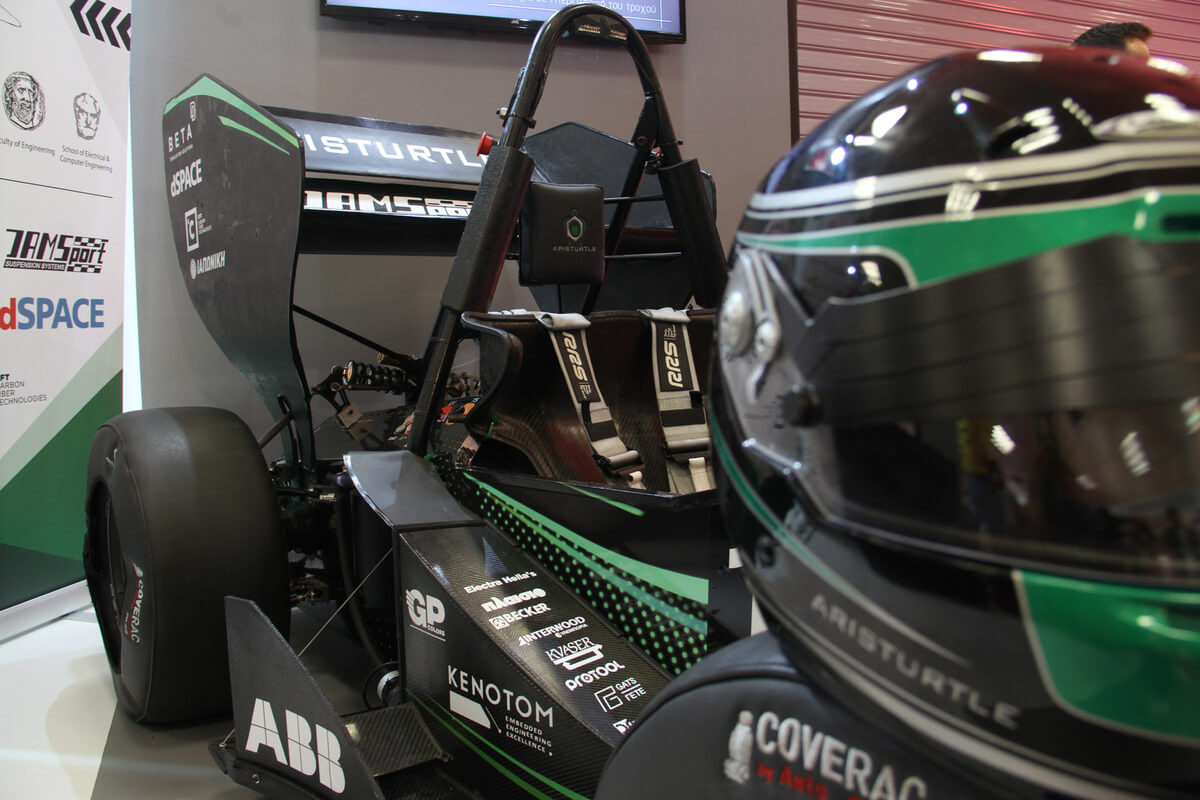The Aristotle University of Thessaloniki – the largest university in Greece – is located in the north of the country, on the Aegean Sea. Their student research team ‘Aristotle University Racing Team Electric & Driverless’, known as Aristurtle, is spearheading the development of autonomous race cars in the Balkan region.
News
The Kvaser Mini PCI Express 2xHS v2 plays a vital role in Aristotle University’s electric driverless vehicle

Electric & autonomous are the automotive future
Aristurtle has manufactured electric vehicles and competed in Formula Student Electric (FSE) since 2015. The team branched out into Driverless Vehicle (DV) in 2019, modifying their electric vehicle to compete in student DV competitions.
Eleni Papageorgiou heads the Autonomous System (AS) sub-team that is responsible for all the driverless aspects of their DV:
“Autonomous driving features are the next major advancement in the automotive industry. We were the first Greek Formula Student (FS) team to announce its commitment towards the creation of a driverless vehicle in March 2019.”
Later that year Formula Student Germany (FSG), the most prestigious Formula Society of Automotive Engineers (Formula SAE)*, announced that by 2022 all teams will compete in a single class consisting solely of vehicles with an electric powertrain and autonomous features, thus confirming Aristutle’s long-term strategy.
In 2021, the team represented the university in a variety of international FS competitions, placing first in Formula Student Austria (FSA) in the Business Plan Presentation Event (for the third consecutive year), successfully passing all the technical inspections. They also participated in the Formula Student East competition with their team’s 5th race car and their first driverless car.
“We are very proud as we ranked third in the DV category of the Skid Pad event, and ninth in the Electric Vehicle (EV) category. And we were awarded the Special Award for the best Business Pitch Video.”
Kvaser's role in Aristurtle’s driverless vehicle
Aristurtle’s team for the 2021-2022 racing season consists of 30 ambitious members with more experience than ever and a huge desire to innovate. Their 6th race car is radically different from previous models; they will design and manufacture a new electric vehicle into which an autonomous system will be integrated, enabling participation in both DV and non-DV competitions.
The team’s most challenging goal going forward is the integration of the autonomous system. The aim is to maintain the performance of their previous car and make on-point changes in order to drive it to even faster lap times whilst at the same time designing detachable and lightweight assemblies that are necessary to make the vehicle driverless.
CAN is the main communication protocol in Aristurtle’s latest car, with the Kvaser Mini PCI Express 2xHS v2 CAN interface used to communicate between the Autonomous Processing Unit (APU) and the car’s wider network of microcontrollers and sensors, allowing data such as steering, brake and throttle commands to be sent and received without delay:

“The Kvaser Mini PCI Express 2xHS v2 plays a vital role in the creation of our driverless vehicle. This component is the bridge between the computer, the Autonomous Processing Unit (APU), where all the algorithms of our “Robotic Operating System” (ROS) run, and the rest of the vehicle.”
Kvaser interfaces were also chosen for another reason:
“The main reason we choose Kvaser products is that they are very well supported with excellent documentation. These characteristics are very important when it comes to choosing your partners; when you think you have reached a dead end it’s vital that your partners can offer you a sense of confidence.”
The name game
Every year the university team chooses an ancient Greek female name for its vehicles; previous cars have been named Eve, Thetis, Electra, and Iris. What 2022’s car will be called hasn’t been decided yet as the name of the vehicle is only chosen at the close of the season. Thus, after the summer competitions have been completed, and the whole team returns home with unforgettable experiences, the name will be chosen:
“This year the countries we are going to visit to compete are Italy at the FSATA competitions, Austria at the FSA, and lastly Hungary with the FSEAST (Formula Student East). This final competition will be very special for us as we are going to compete in it as a driverless team, the only one from Greece.”
Kvaser is very proud to be a part of Aristurtle’s project and achievements and we wish them a great 2021-2022 season. We’re also looking forward to finding out what they decide to call their car!
*The Formula SAE series competitions challenge teams of university undergraduate and graduate students to conceive, design, fabricate, develop, and compete with small, formula-style vehicles. The competitions give teams the chance to demonstrate and prove both their creativity and engineering skills in comparison to teams from other universities around the world.
Which Kvaser products are they using?

Kvaser Mini PCI Express 2xHS v2, a small (30 x 51mm), yet advanced, real time CAN interface that adds two high speed CAN or CAN FD channels to any standard computer with mini PCI Express capability. PC communication is over the PCI Express system bus, making for extremely low latency with a time stamp accuracy of 1 µs.
https://www.kvaser.com/product/kvaser-mini-pci-express-2xhs-v2/
Kvaser USBcan Light 4xHS, a compact, reliable and cost-effective means of connecting four high speed CAN buses to a PC or mobile computer. With galvanic isolation as standard, this USB to quad channel CAN interface has a standard USB connector at one end and four high speed CAN channels in a single 26-pin HD D-SUB CAN connector at the other. The supplied HD26-4xDS9 splitter can be used to connect to four separate 9pin DSUB connectors.
https://www.kvaser.com/product/kvaser-usbcan-light-4xhs/
Who is involved?
Aristurtle
https://www.aristurtle.gr/
Kvaser
https://www.kvaser.com/
 linkedin
linkedin twitter
twitter youtube
youtube youku
youku weixin
weixin